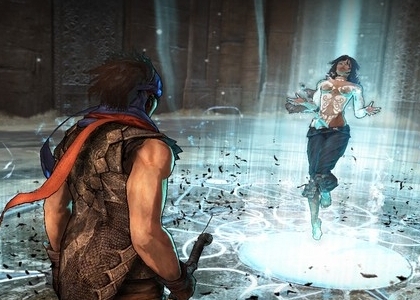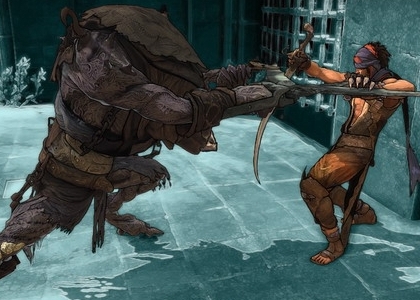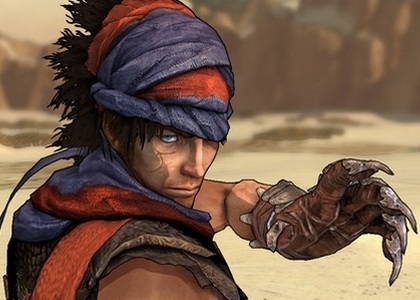Released in mid-December 2008 by Ubisoft Montreal (publishers of the hit Prince of Persia: Sands of Time series and Assassin’s Creed), the new Prince of Persia (available for the 360, PS3, and PC) is a marked departure from the franchise-launching Sands of Time. Major gameplay elements like the time-rewind control are gone in favor of a simplified control scheme that is friendlier to new players, but may be a little too hands-off for veterans. There’s even a new story, unrelated to the original, with brand new characters and a different focus for the protagonist. While I miss the old prince and more intense combat, I really like the new direction for the series. This is definitely the best time for new players to jump in.
I really enjoyed the original Sands of Time story. The SoT Prince was an interesting, flawed character, and his quest for redemption was the driving force, so I was surprised to discover that the new Prince’s place in the Prince of Persia is completely incidental. The plot really centers on Elika, a mysterious girl fighting for the fate of the world against a corrupt dark god, whom the Prince runs into wandering in the wilderness. Though their relationship evolves over the course of the game, it takes three or four hours for the Prince to develop any real motivation beyond, “Hey, she’s cute, and the world’s ending so I’ve got nothing better to do.” Fans of the first prince might have difficulty immediately relating to the new prince, who has none of the emotional involvement of the last one. New players will probably appreciate that a great deal.

I have to wonder if Ubisoft is actively trying to attract more female gamers with the new prince. He’s self-assured, confident, and decisive, yet isn’t the central character for most of the story. Elika doesn’t need him to rescue her (and in fact, does most of the rescuing), she really only needs his help so she can save the world.
In previous Prince of Persia games, players could rewind time to undo a fatal mistake. This control is gone entirely; Elika waves her hand automatically and saves you if you fall off a cliff or fail to make a jump or otherwise fail to live. I was initially concerned that this feature would make the game too easy, but after a few hours of exploring (and falling off many cliffs) I was grateful for the change. Ubisoft made a smart move here—players no longer have to remember to hit the “oops” trigger in time, and can focus instead on exploring and admiring the visuals. The cell-shaded graphic look is a first for the series, but is very well suited for the new artistic direction and is just a pleasure to look at.
The previous games tended towards linear room-by-room progression. You entered individual rooms in order, solved that room’s trap, and continued. The new Prince of Persia now has an open, exploratory model of progression. Players choose where they want to go across one persistent game world, and rather than solve individual room puzzles, players use Elika to “cleanse” the corrupted areas, and then use the Prince to collect “light seeds” which give the heroic pair access to new powers and new areas. I loved this model in Assassin’s Creed, and it’s my favorite part of the game now. Ubisoft did a great job making the paths to new areas difficult to get to but easy to find, so you’re always encouraged with where you need to go.
The new control scheme will be the make-or-break feature for most players. The simplified scheme allows players to complete most of the acrobatic moves with a single tap of a button. After the prince has completed his move, players can tap again to begin the next. At first, I felt like I wasn’t directly controlling the prince, just telling him what to do and waiting for him to do it. After a while though, I began to enjoy the simplicity of the controls because I could enjoy looking at the beautiful game environment instead of focusing on my fingers.

Combat has received the same treatment, using single button combos against individual enemies as opposed to memorizing long lists of combos, grabs, and special attacks to fight off large groups. Similar to Zelda, of all things, you use small, simple combos to maneuver the opponent into the right position/situation before dealing a cinematically-assisted final blow. Unlike the move commands, I found combat hard to acclimate to. I liked the flowing, chaotic combat style in the latter two SoT games, as well as games like God of War, and I found the scripted combat unsatisfying.
Players looking to spend their post-holiday gift certificates on challenging fare might be better off with Mirror’s Edge, but players looking for an expansive exploratory experience wrapped in a little mystique and fantasy will love this game. Veteran players need to shed some expectations, but will eventually realize that the old gameplay really wouldn’t have worked too well with the new features. Despite some initial misgivings, Ubisoft did an all-around solid job with Prince of Persia and I’m looking forward to the (expected) sequels.
Pet Peeve: Maybe it’s a royal character flaw, but princes of Persia apparently can’t stop talking. The SoT prince whined like a Final Fantasy character, and the new guy is even worse—he thinks he’s funny. And charming. I wanted to heave my 360 out the window after the 7th flirtatious quip in 25 minutes.










